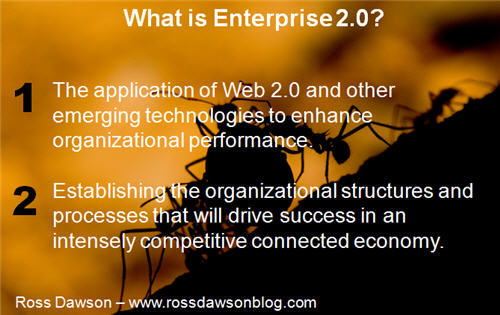Enterprise 2.0: Competitive differentiation occurs at the intersection of technology and culture
Recently I have been immersing myself in the Enterprise 2.0 space, organizing the second annual Enterprise 2.0 Executive Forum which is on in two weeks now, writing the Implementing Enterprise 2.0 Report which will be launched at the same time (slightly afterwards for the international market), and helping a variety of large organizations to drive their Enterprise 2.0 initiatives forward.
It’s a long time since I came up with my definition for Enterprise 2.0 as below. While I generally dislike jargon and the liberal addition of “2.0” to words, I find the term Enterprise 2.0 highly meaningful because it is, in addition to tapping the value of Web 2.0 in a specific context, literally about creating the next version of the organization.

What that stayed with me more than anything else from Andrew McAfee’s speech at our inaugural Enterprise 2.0 Executive Forum last year, is one of his key conclusions: “Enterprise 2.0 will make companies less similar” (or as I always remembered it, ‘Enterprise 2.0 makes companies more different’).
Indeed, from a corporate perspective I think that Enterprise 2.0 is meaningless unless it results in competitive advantage, making organizations truly different from their competitors. While I fundamentally disagree with Nicholas Carr’s thesis that ‘IT doesn’t matter’, the reality is he is largely right when considering most enterprise technology up until now, which has focused on business processes. However Enterprise 2.0 is in a completely class because it is fundamentally social: it is about how people connect. Anyone who has been exposed to Web 2.0-style initiatives in organizations knows that how people use (or don’t use) social technologies are largely a function of the culture of the organization.
As such, any Enterprise 2.0 initiatives sit squarely at the intersection of technology and culture. These are technologies that facilitate interaction and the creation of value through participation, but the technologies are only as valuable as people’s desire to interact, collaborate, and create something worthwhile together.
This means that any attempt to implement Enterprise 2.0 tools and approaches are dependent on both the culture of the organization today, but even more importantly, where the culture of the organization is heading. No change is almost as bad as a poor culture. The culture must be dynamic and have positive momentum for Enterprise 2.0 approaches to thrive and prosper, as they are all about making things different.
There is no one-size-fits-all for Enterprise 2.0 implementation. While we can certainly learn from what others have done well and not-so-well, every organization must find the path to value that will prosper in its own unique conditions. And so far the record is that fewer organizations have succeeded massively than have failed. This is not an easy path to take.
This means that any successful implementation of Enterprise 2.0 CANNOT be replicated. Since it exists at the intersection of technology and culture, no other company can duplicate what it has done, buy the same technology and set up the same pilots, and expect anything like the same thing to happen.
It is precisely the challenges of creating value from Enterprise 2.0 that make it so valuable. If you do it well, you will absolutely have created a more efficient, effective, productive, innovative, engaged organization than your competitors. And they won’t have a hope of doing the same.
